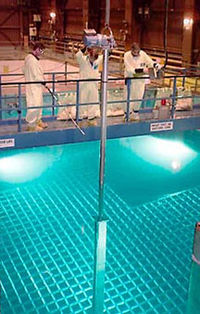
Photo from wikipedia
The KLT-40S is a small modular reactor developed by Russia based on the KLT-40 reactor with two fuel assembly designs: a four-ring and a five-ring. Few studies have been published… Click to show full abstract
The KLT-40S is a small modular reactor developed by Russia based on the KLT-40 reactor with two fuel assembly designs: a four-ring and a five-ring. Few studies have been published on fuel assembly and power-flattening designs for the KLT-40S. In this paper, the effects of different fuel assembly designs on burnup and power flattening are investigated. This paper compares the effects of the two fuel assembly designs of the KLT-40S on its burnup characteristics, analyzes the effects of fuel rod diameter on burnup characteristics, and conducts a computational study on the ideal power-flattening design. The results show that the five-ring fuel assembly design has better burnup characteristics than the four-ring fuel assembly design. At a fuel rod diameter of 0.62 cm, the optimal burnup lattice is obtained. The 15.84% + 19.75% power-flattening design (uranium enrichment in the innermost and outermost rings + uranium enrichment in inner rings) reduces the local power peaking factor of the five-ring fuel assembly below 1.11 throughout the lifetime. Therefore, the KLT-40S five-ring fuel assembly has better burnup characteristics, and its optimal burnup lattice is at the 0.62 cm fuel rod diameter. The use of power-flattening designs can effectively reduce the local power peaking factor.
Journal Title: Energies
Year Published: 2023
Link to full text (if available)
Share on Social Media: Sign Up to like & get
recommendations!